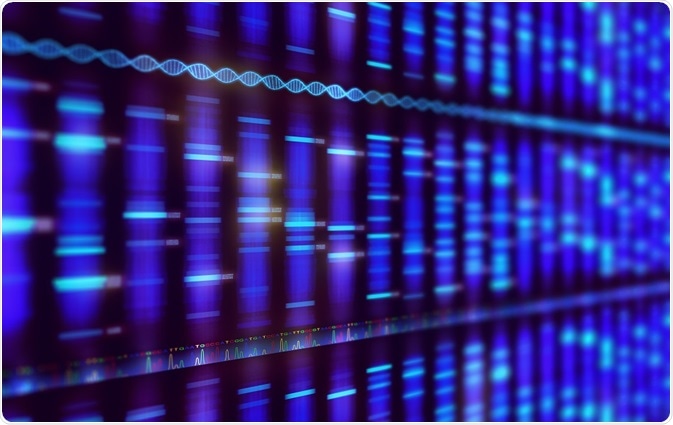Challenges with Sanger Sequencing
Sanger sequencing is a method of sequencing DNA developed by Frederick Sanger in 1977. In Sanger sequencing, chain-terminating dideoxynucleotides are incorporated into the growing DNA chain at random positions. The sequence is then inferred from the set of incrementally terminated DNA chains separated by polyacrylamide gel electrophoresis. More recently, next generation sequencing (NGS) has begun to replace Sanger sequencing, primarily because it is able to sequence millions of DNA fragments simultaneously, compared to only 384 for Sanger sequencing.

Credit: Ktsdesign/ Shutterstock.com
Limitations of Sanger Sequencing
Sanger sequencing has a number of limitations that can lead to problems with results and difficulty using the method in general:
- Sanger methods can only sequence short pieces of DNA--about 300 to 1000 base pairs.
- The quality of a Sanger sequence is often not very good in the first 15 to 40 bases because that is where the primer binds.
- Sequence quality degrades after 700 to 900 bases.
- If the DNA fragment being sequenced has been cloned, some of the cloning vector sequence may find its way into the final sequence.
Cost effectiveness
With advances in next generation sequencing, the relative cost effectiveness of Sanger sequencing has changed. Sanger sequencing is relatively expensive, running about $500 per 1000 bases, compared to less than $0.50 per 1000 bases for next generation sequencing, according to a 2011 study.
A study of costs for viral gene sequencing published in The Lancet in 2016 showed that with Sanger sequencing, the mean cost per sample for hepatitis C virus (HCV) was £178 and for HIV was £79. Next generation sequencing beat those numbers, coming in at £59 for HCV and £40 for HIV.
Sanger may not be accurate for validation
Sanger sequencing is widely used to validate next generation sequencing results because Sanger sequencing is considered to be more accurate. However, a recent study from the National Human Genome Research Institute shows that may not be true. The group of researchers compared DNA samples from a genomic sequencing project that had been analyzed by both next generation and Sanger methods.
In a group of 19 genes in five participants, results from both sequencing methods revealed 234 gene variants. The results were the same for both methods, suggesting that Sanger validation was not necessary or helpful. In a group of five genes from 684 participants, 5660 variants were identified by next generation sequencing. Of that group, Sanger sequencing missed 19 variants. A second round of Sanger sequencing then identified all but two of those 19. This suggests that Sanger confirmation would cause more diagnostic errors in a clinical setting than it would correct.
When to use Sanger sequencing
Next generation sequencing technology is now preferred for certain jobs. Those include:
- sequencing more than 100 genes simultaneously
- expanding the number of targets to find novel variants
- samples with low input amounts of starting material
- microbial genomes for pathogen subtyping in critical outbreak situations
Sanger sequencing is still a good choice when:
- sequencing single genes
- Sequencing amplicon targets up to 100 base pairs
- sequencing 96 samples or less
- identifying of microbes
- analyzing fragments
- analyzing short tandem repeats (STRs)
Sources:
- New study challenges gold standard for validating DNA sequencing results, www.genome.gov/.../
- When do I use Sanger sequencing vs. NGS?, www.thermofisher.com/.../when-do-i-use-sanger-sequencing-vs-ngs-seq-it-out-7
- Next Generation DNA Sequencing: A Review of the Cost Effectiveness and Guidelines, https://www.ncbi.nlm.nih.gov/books/NBK274079/
- Cost analysis of standard Sanger sequencing versus next generation sequencing in the ICONIC study, www.thelancet.com/.../fulltext
- Next steps in the sequence, https://www.phgfoundation.org/report/next-steps-in-the-sequence
Further Reading
Last Updated: Jul 19, 2023